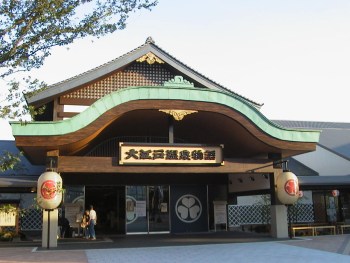|
|
| Make a
Reservation at a Ryokan (Traditional Japanese Inn) Anywhere in Japan |
Home >
Introduction to Japanese Hot Springs
 Copyright D Paget, All Rights Reserved, 2003 Copyright D Paget, All Rights Reserved, 2003
|
Introduction to Japanese Hot Springs |
| Hot springs have a very long history in
Japan, and they are an intimate part of Japanese culture. There are
over 3,000 "onsen" - or hot springs - in Japan, many which
can be found at the ryokans listed at Japanese Guest Houses. Onsen are created from water
heated naturally underground, and the water varies both in degrees
and in mineral composition. The water is piped into the ryokans or
other establishments, and then regulated at various temperatures.
At many ryokans, there will be large indoor onsen for both men and
women. They may often have several pools with wall-length windows
where you can look out over a garden, river, or another natural setting.
The interior may be lined with natural rocks and decorated with various
kinds of tropical plants. There are also outdoor onsen called "rotenburo." At
some ryokans they can be found nearby, and they are often open
all night. The outdoor onsen can be more rustic than the indoor onsen,
and often they do not have any changing rooms.
Using an Onsen
- enter the changing room (one for women and one for men)
- remove your clothes and put them in the basket or locker
provided
- take the wash towel with you (one will be provided for you)
- cover your private parts and enter the bathing area closing any
door behind you
- wash your body using the showers or taps before entering the hot
spring bath
- relax in the bath for a short while and be careful not to get
too hot
- if there is both an indoor and an outdoor bath, you can enjoy both baths
- after your last soak in the bath, you do not need to rinse your
body
Onsen Etiquette
- Onsen are for soaking your body, not washing your body. Before
you enter the water, it is important to wash your body and rinse
all the soap from your body. There will be a shower and/or tap
in the onsen where you can wash yourself before entering the
water.
- Unlike hot springs in some countries, bathers do not wear any
clothes in a Japanese onsen. Most onsen have both male and female
baths, together with separate changing rooms. The only things
you should bring with you to the onsen are soap, shampoo, and a
small towel.
- An onsen is for relaxing, not swimming. Just sit back and let
the mineral water soak into the pores of your skin. It is a wonderful
way to relax and unwind, and you will feel squeaky clean and
very refreshed at the end of your bath. Avoid rough horseplay
and making loud noises as the atmosphere at an onsen is suppose to
be for relaxation and quiet conversation.
- Before stepping into the water, it is a good idea to test the
temperature with your foot so you have some idea of the water
temperature. Some onsen can be very hot! If you have heart trouble
or high blood pressure, do not stay in the water for more than
a few minutes.
- If you wear glasses, do not take them with you to an outdoor
hot spring. The difference in air temperature between sitting
in the hot spring and the outside air may cause your glasses
to crack once you leave the hot spring.
|
 |
|
 |
Rediscover Japan Co., Ltd. (dba Japanese Guest Houses)
Hyogo-ken Chijitoroku Ryokogyo 3-609 (Hyogo Prefecture Travel Agent License Number 3-609)
10-5-401-1-(2) Sakae-machi, Kawanishi-shi, Hyogo-ken 666-0033 Japan
Staff at Japanese Guest Houses
Copyright © 2000-2008 Rediscover Japan Co., Ltd. All Rights Reserved. Privacy Policy |
|
